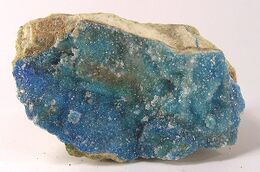Chemistry:Kinoite
From HandWiki
| Kinoite | |
|---|---|
 | |
| General | |
| Category | Sorosilicate |
| Formula (repeating unit) | Ca 2Cu 2Si 3O 8(OH) 4 |
| Strunz classification | 9.BH.10 |
| Crystal system | Monoclinic |
| Crystal class | Prismatic (2/m) (same H-M symbol) |
| Space group | P21/m |
| Unit cell | a = 6.99, b = 12.88 c = 5.65 [Å]; β = 96.18°; Z = 2 |
| Identification | |
| Formula mass | 450amu |
| Colour | Transparent deep blueTransparent deep blue |
| Cleavage | excellent {010}, distinct {001} and {100} |
| Mohs scale hardness | 2 1⁄2 |
| |re|er}} | Vitreous |
| Diaphaneity | Transparent |
| Specific gravity | 3.13 – 3.19 |
| Density | 3.13 – 3.19 |
| Optical properties | Biaxial (−) |
| Refractive index | nα = 1.638 nβ = 1.665 nγ = 1.676 |
| Birefringence | δ = 0.038 |
| Pleochroism | Strong |
| 2V angle | Measured: 68° , calculated: 64° |
| Dispersion | relatively weak |
Kinoite (Ca
2Cu
2Si
3O
8(OH)
4[2][3] or Ca
2Cu
2Si
3O
10 · 2 H
2O[4]) is a light blue copper silicate mineral. It is somewhat scarce. It has a monoclinic crystal system, vitreous luster, and is transparent to translucent. It can be found in the Santa Rita Mountains, the Christmas Mine at Christmas, Arizona and a few other copper mines. Kinoite is popular with mineral collectors. Kinoite was named upon its discovery in 1970 after the pioneer Jesuit missionary Padre Eusebio Kino who worked in Arizona, Sonora and Baja California.
References
- ↑ Warr, L.N. (2021). "IMA–CNMNC approved mineral symbols". Mineralogical Magazine 85 (3): 291–320. doi:10.1180/mgm.2021.43. Bibcode: 2021MinM...85..291W.
- ↑ Handbook of Mineralogy
- ↑ Kinoite at Webmineral
- ↑ Kinoite at Mindat.org
 |

